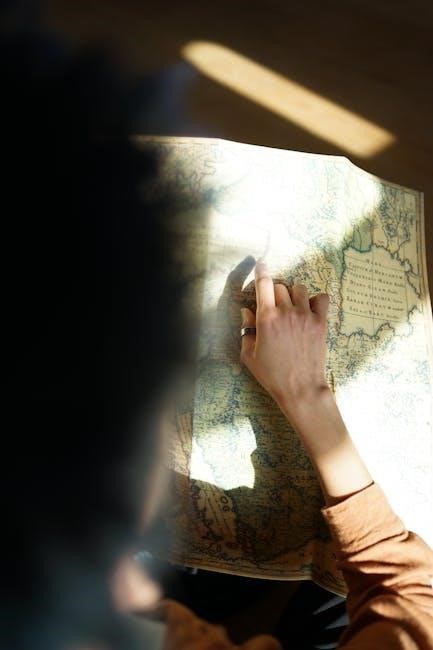Dance is a captivating art form that expresses emotions, tells stories, and connects people across cultures. It combines movement, rhythm, and creativity, serving as a universal language of human expression.
1.1 The Definition and Significance of Dance
Dance is the deliberate movement of the body, expressing ideas, emotions, and narratives through rhythm, space, and gesture. It serves as a universal language, transcending verbal communication. Dance holds profound significance as a cultural identifier, preserving traditions and fostering social unity. It enhances physical fitness, mental well-being, and creative expression, making it an integral part of human life and artistic education. Through its versatility, dance connects individuals and cultures, acting as a powerful medium for storytelling and self-discovery.
1.2 The Role of Dance in Culture and Society
Dance plays a vital role in culture and society, serving as a universal language that bridges cultural divides; It is a powerful medium for storytelling, preserving traditions, and celebrating heritage. Through rituals, ceremonies, and social gatherings, dance fosters unity and strengthens community bonds. It reflects societal values, challenges norms, and inspires change. Across cultures, dance is used to express joy, mourn losses, and mark life milestones. Its ability to transcend words makes it a unique tool for communication and cultural exchange, enriching human experiences globally.

Historical Development of Dance
Dance has evolved from ancient rituals to contemporary forms, reflecting cultural, social, and artistic transformations across centuries. Its history traces the adaptation of movements and styles over time.
2.1 The Origins of Dance
Dance is a universal language rooted in ancient human expression, serving as a primal form of communication and storytelling. Early evidence suggests its origins in rituals, ceremonies, and social interactions, with movements reflecting cultural and spiritual beliefs. From tribal dances to sacred rituals, dance was integral to survival, celebration, and community bonding. Its evolution is traced through ancient civilizations, such as Egypt, where dance was a vital part of religious and cultural practices, and tribal communities, where it remains a cornerstone of identity and tradition.
2.2 Evolution of Dance Through the Ages
Dance has evolved significantly over centuries, shaped by cultural, social, and artistic transformations; From ancient rituals to modern performances, it has adapted to changing societies. The Renaissance brought structured ballet, while the 20th century introduced modern and contemporary styles. Jazz and tap dance emerged in the 19th and 20th centuries, emphasizing rhythm and showmanship. Ballroom dance gained popularity in the 16th century, evolving into partner-based styles like waltz and tango. Today, dance continues to blend traditional techniques with contemporary influences, reflecting a dynamic art form.
2.3 Key Historical Periods in Dance
Dance history is marked by distinct periods that shaped its evolution. The Renaissance introduced structured ballet in Italy and France. The Romantic era of the 19th century emphasized dramatic expression in ballets like Giselle. The early 20th century saw the rise of modern dance, led by pioneers like Martha Graham. Jazz and tap dance flourished in the 1920s-1940s, rooted in African-American vernacular traditions. Ballroom dance emerged in 16th-century Europe, evolving into styles like waltz and tango. Each period reflects societal changes and artistic innovation, leaving a lasting impact on dance as an art form.

Major Dance Styles and Their Characteristics
Dance encompasses diverse styles, each with unique traits. Ballet emphasizes precision and grace, while contemporary focuses on emotional expression. Ballroom highlights partner synchronization, jazz combines rhythm and showmanship, and modern dance explores free-form movements, reflecting individuality and creativity.
3.1 Ballet: Technique and History
Ballet is a classical dance form characterized by precise techniques, graceful movements, and a rich historical background. Originating in Italy in the 15th century, it evolved into a prominent art form in France and Russia. Ballet technique focuses on alignment, posture, and turnout, with movements such as arabesques, pirouettes, and fouettés. The history of ballet is marked by iconic works like “Swan Lake” and “The Nutcracker,” which continue to influence contemporary performances. Proper training and dedication are essential for mastering this demanding yet elegant style.
3.2 Contemporary Dance: Principles and Influences
Contemporary dance blends modern, jazz, and ballet techniques with emotional expression. It emphasizes fluidity, natural movement, and personal interpretation. Influenced by pioneers like Martha Graham, it often explores themes of identity and social issues. Contemporary dance encourages improvisation and collaboration, making it versatile and dynamic; It is characterized by floorwork, contact improvisation, and the use of breath to connect mind and body. This style fosters creativity and self-expression, making it a popular choice for both dancers and choreographers in today’s diverse artistic landscape.
3.3 Ballroom Dance: Styles and Partner Work
Ballroom dance encompasses a variety of styles, including Waltz, Tango, and Foxtrot. It emphasizes precise movements, rhythm, and elegant partnering. The art form requires synchronization between partners, focusing on lead-follow dynamics. Ballroom dance is often performed in pairs, highlighting trust and coordination. Its structured techniques and graceful aesthetics make it a timeless favorite for both social and competitive settings. The dance style has evolved over centuries, blending tradition with modern flair, and continues to captivate audiences and dancers alike with its beauty and sophistication.
3.4 Jazz and Tap Dance: Rhythm and Showmanship
Jazz dance combines high-energy movements with vibrant music, emphasizing rhythm and showmanship. It often incorporates acrobatics and dramatic expressions. Tap dance, on the other hand, focuses on percussive sounds created by metal plates on the dancer’s feet. Both styles require precision and musicality, blending technical skill with artistic flair. Jazz dance is dynamic and theatrical, while tap dance highlights intricate footwork and rhythm. Together, they create a powerful blend of sound and motion, captivating audiences with their unique energy and storytelling abilities.
3.5 Modern and Contemporary Dance: Expressive Movements
Modern and Contemporary Dance emphasize emotional expression through fluid, natural movements. They encourage spontaneity and personal interpretation, breaking from traditional structures. Contemporary Dance often blends elements from Modern, Jazz, and Ballet, focusing on storytelling and connection. Both styles prioritize the dancer’s individuality and artistic voice, creating a powerful medium for self-expression. Influenced by pioneers like Martha Graham, these forms continue to evolve, inspiring new generations of dancers to explore and innovate.

Study Resources and Guides for Dance Students
Recommended books and online tools provide comprehensive guides for dance students, covering technique, history, and practical advice for mastering various dance styles effectively.
4.1 Recommended Books for Dance Students
The Dancers Study Guide by Anthony King offers comprehensive insights into technique, choreography, and the industry. Studying Dance: A Guide for Campus and Beyond by Karen Schupp provides practical advice for academic and professional growth. Your Move by Ann Hutchinson Guest focuses on movement analysis, essential for understanding dance as an art form. These books, along with others, cover the history, technique, and cultural aspects of dance, making them invaluable resources for students seeking a well-rounded education in dance.
4.2 Online Tools and Platforms for Dance Learning
Online platforms like Codarts Rotterdam and Study Guide Codarts Dance 2024-2025 offer comprehensive resources for dance students. Websites provide interactive learning tools, virtual classes, and tutorials covering various dance styles. Flashcards and study guides on platforms like Quizlet help memorize key terms and concepts. Additionally, online communities and forums connect dancers worldwide, fostering collaboration and knowledge sharing. These digital resources enhance learning, making dance education accessible and engaging for students of all levels.
4.3 Study Guides for Specific Dance Techniques
Study guides like “The Dancers Study Guide by Anthony King” and “Studying Dance: A Guide for Campus and Beyond by Karen Schupp” provide in-depth insights into specific dance techniques. These resources cover ballet basics, stretching exercises, and dance vocabulary, offering practical advice and theoretical frameworks. They cater to both beginners and advanced dancers, ensuring a comprehensive understanding of various dance styles. Such guides are essential for structured learning and mastering techniques, making them invaluable for aspiring dancers seeking to refine their skills and artistry.
Technique and Training in Dance
Dance technique involves mastering alignment, posture, and movement precision. Training includes structured exercises for flexibility, strength, and coordination, essential for building a strong foundation in dance artistry.
5.1 Ballet Basics: Alignment and Posture
Ballet technique begins with proper alignment and posture. Dancers learn to maintain a neutral spine, engage core muscles, and hold their heads high. Correct alignment ensures movements are executed safely and gracefully. Posture is fundamental to balance and aesthetics. Through barre exercises and floor work, dancers develop strength and awareness. Proper alignment prevents injuries and enhances overall performance quality. Mastery of these basics is crucial for advancing in ballet and other dance forms.
5.2 Stretching and Flexibility Exercises
Stretching and flexibility exercises are vital for dancers to enhance range of motion and prevent injuries. Techniques include static stretches for hamstrings, hip flexors, and calves, as well as dynamic stretches to improve mobility. Proper warm-up routines prepare the body for movement, while cool-down stretches aid recovery. Consistent practice increases flexibility and allows for more precise and fluid dance movements, essential for achieving technical proficiency in various dance styles.
5.3 Dance Vocabulary: Key Terms and Movements
Dance vocabulary forms the foundation of movement, comprising essential terms and techniques that define various styles. Key movements include pliés, arabesques, and jetés in ballet, while contemporary dance emphasizes contractions and spirals. Understanding terms like alignment, posture, and coordination is crucial for mastering techniques. These movements, when executed correctly, enable dancers to convey emotions and tell stories effectively, making them fundamental to both practice and performance across all dance genres.

Cultural and Social Aspects of Dance
Dance is a universal language that bridges cultures, fostering connection and understanding. It reflects societal norms, traditions, and values, serving as a powerful tool for expression and unity.
6.1 Dance as a Form of Non-Verbal Communication
Dance is a powerful medium of non-verbal communication, conveying emotions, ideas, and narratives without words. It uses body language, facial expressions, and movement dynamics to transmit messages, fostering empathy and connection. Through precise gestures and fluid transitions, dancers can express complex feelings, making it accessible across cultural boundaries. This universal language allows people to communicate effectively, transcending verbal limitations and creating a profound impact on audiences worldwide.
6.2 The Role of Dance in Rituals and Ceremonies
Dance plays a vital role in rituals and ceremonies, serving as a bridge between the spiritual and physical worlds. It is often used to celebrate life events, honor deities, or mark transitions, fostering community unity. From weddings to initiation rites, dance rituals convey cultural values and traditions, reinforcing social bonds. Its rhythmic movements and symbolic gestures create a shared experience, connecting participants to their heritage and fostering a sense of belonging. Dance in ceremonies is a timeless expression of human spirituality and cultural identity.
6.3 Dance Across Different Cultures and Traditions
Dance is a universal language, with each culture offering unique styles and traditions. From the graceful ballet of Europe to the vibrant Bharatanatyam of India, dance reflects cultural identity. African tribes use rhythmic movements to tell stories, while Latin America’s salsa embodies passion and energy. In Asia, the delicate gestures of kabuki theater contrast with the dynamic lion dances of China. Each tradition, with its distinct techniques and costumes, showcases the diversity and richness of global dance heritage, preserving history and fostering cross-cultural understanding;
Dance continues to evolve, blending tradition with innovation. As technology advances, new platforms emerge for learning and sharing dance, ensuring its enduring relevance and global appeal.
7.1 The Evolution of Dance in the Modern World
Dance has transformed significantly in the modern era, influenced by technology, social media, and cultural exchange. Platforms like YouTube and TikTok have democratized dance learning, allowing global access to diverse styles. Contemporary and fusion dances blend traditional techniques with new expressions, reflecting today’s dynamic world. The rise of virtual reality and online classes has also redefined how dance is taught and experienced, ensuring its continued evolution and accessibility for future generations.
7.2 Career Opportunities in Dance
Dance offers a variety of rewarding career paths, from professional performer and choreographer to instructor and dance therapist. Aspiring dancers can pursue roles in ballet, contemporary, or commercial dance companies. Teaching opportunities exist in schools, studios, and online platforms, while choreographers can work in theater, film, or television. Dance therapists use movement to aid mental and physical well-being. With growing demand for dance professionals in entertainment, fitness, and education, the field continues to expand, providing diverse opportunities for passionate individuals to turn their love for dance into a fulfilling career.
